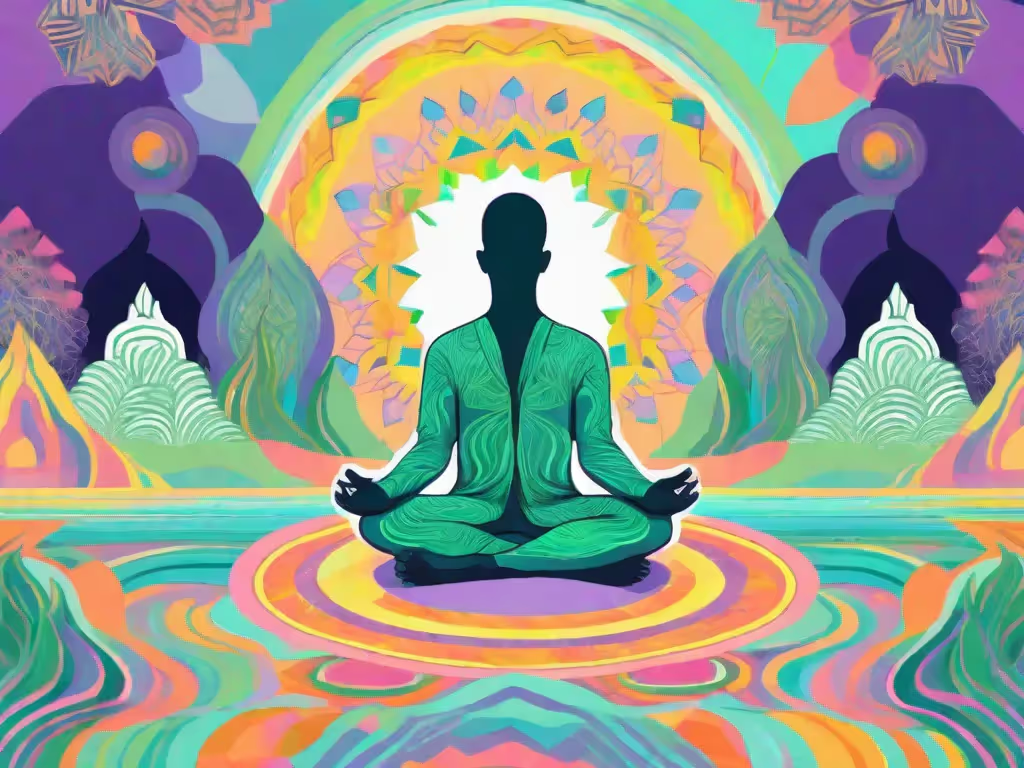The 4 Best Meditation Positions - Aura
Embarking on a meditation journey can be transformative, offering a plethora of benefits for both mind and body. However, one common stumbling block for many beginners is finding a comfortable meditation position. The right posture can significantly enhance your meditation experience, making it easier to focus and stay present. In this guide, we'll explore the four best meditation positions that cater to various needs and preferences, ensuring your meditation practice is both effective and enjoyable.
Understanding Meditation Positions
Before diving into the specific positions, it's important to understand why the right posture matters in meditation. A good position supports the body in a way that promotes relaxation, enhances concentration, and allows energy to flow freely. It also minimizes discomfort and distractions, helping you maintain focus throughout your practice.
Recent data shows that comfort and alignment are key factors in sustaining a meditation practice over time. This may be because a comfortable posture reduces the effort needed to stay focused, making meditation feel more accessible and enjoyable.
Finding Your Ideal Posture
When exploring meditation positions, consider your body's unique needs and limitations. Some may find sitting on the floor uncomfortable, while others might struggle with maintaining a straight back. It's crucial to listen to your body and adjust accordingly, using props like cushions or chairs if needed.
Despite that, the goal is to find a posture that feels both comfortable and alert, avoiding positions that might lead to drowsiness. Experimenting with different positions can help you discover what works best for you.
The Seated Position
The seated position is perhaps the most iconic and widely used posture in meditation. It's versatile, allowing for various adaptations to accommodate different body types and flexibility levels.
Classic Cross-legged
Sitting cross-legged on the floor is a traditional meditation posture that promotes grounding and stability. For added comfort, sitting on a cushion can help elevate the hips, making it easier to maintain a straight spine. This position is ideal for those who have a good range of flexibility in their hips and knees.
However, it's important to note that sitting for extended periods in this position may not be suitable for everyone, especially those with knee or hip issues. In such cases, modifications or alternative positions may be more appropriate.
Chair Seated
For those who find sitting on the floor challenging, the chair-seated position offers an excellent alternative. Sitting on a chair with feet flat on the ground and a straight back can provide the necessary support without compromising the benefits of meditation. This position is particularly beneficial for individuals with limited mobility or those who experience discomfort when sitting on the floor.
Ensuring the chair is the right height so that the knees are at a 90-degree angle can further enhance comfort and alignment. This position demonstrates that meditation is accessible to everyone, regardless of physical limitations.
The Kneeling Position
The kneeling position, also known as "seiza," is another effective posture for meditation. It involves kneeling on the floor with the tops of the feet flat against the ground, sitting back on the heels.

Using Props for Support
While the kneeling position can provide a stable base for meditation, it may be uncomfortable for some, especially on the knees and ankles. Using props like a meditation bench or a folded blanket under the ankles can offer additional support and alleviate discomfort.
This position is a good option for those looking for an alternative to sitting that still allows for a straight spine and aligned posture. It's also beneficial for individuals who prefer a more active engagement of the core muscles during meditation.
The Lying Down Position
The lying down position, or "Savasana," is often used in yoga and can be a deeply relaxing posture for meditation. It involves lying flat on the back with the arms and legs slightly spread apart, palms facing up.
Ensuring Alertness
While the lying down position is exceptionally comfortable, it's important to maintain alertness to avoid drifting off to sleep. Focusing on the breath or using a guided meditation can help keep the mind engaged and present.
This position is ideal for those seeking relaxation or individuals with back pain that makes sitting or kneeling uncomfortable. It's a reminder that meditation can be adapted to meet the needs of every practitioner, ensuring a positive and beneficial experience.
Additional Meditation Positions
Aside from the four main meditation positions discussed above, there are other variations that you can explore to find what works best for you. These positions cater to different preferences and physical abilities, allowing you to customize your meditation practice further.
Standing Meditation
Standing meditation is a dynamic posture that can be beneficial for those who find sitting for extended periods uncomfortable. It promotes a sense of grounding and stability while allowing for a straight spine and open chest, facilitating deep breathing and relaxation.
To practice standing meditation, stand with your feet hip-width apart, knees slightly bent, and arms relaxed by your sides. Close your eyes or soften your gaze, focusing on your breath and the sensations in your body. This position can be particularly useful for individuals who prefer movement or have difficulty sitting for long periods.
Walking Meditation
Walking meditation is a mindful practice that combines the benefits of meditation with physical movement. It involves walking slowly and deliberately, paying attention to each step and the sensations in your body. This form of meditation can be especially beneficial for those who struggle with sitting still or find it challenging to quiet the mind.
To practice walking meditation, find a quiet space where you can walk back and forth mindfully. Focus on the sensations in your feet as they make contact with the ground, maintaining a steady and deliberate pace. Walking meditation can help cultivate presence and awareness in everyday activities.
Exploring Meditation Props
Using props in your meditation practice can enhance comfort, support proper alignment, and alleviate physical discomfort. Props come in various forms and can be particularly useful for individuals with limited flexibility, injuries, or chronic pain. Here are some common meditation props you may consider incorporating into your practice:

Meditation Cushions
Meditation cushions, also known as zafus, are firm yet comfortable cushions designed to support your hips and lower back during meditation. They help elevate the hips above the knees when sitting cross-legged, promoting a natural curve in the spine and reducing strain on the lower back.
When choosing a meditation cushion, opt for one that suits your body size and provides adequate support. Some cushions come with removable covers for easy cleaning, while others offer adjustable firmness to accommodate individual preferences.
Meditation Benches
Meditation benches are wooden or cushioned platforms that elevate the hips and angle the pelvis slightly forward, promoting an upright posture during meditation. They can be particularly beneficial for individuals with tight hips or those who experience discomfort when sitting on the floor.
When using a meditation bench, kneel on the bench with your legs tucked underneath and your spine straight. The bench helps reduce strain on the knees and ankles while providing a stable base for meditation practice.
Blankets and Bolsters
Blankets and bolsters are versatile props that can be used to support various meditation postures, including sitting, kneeling, and lying down. Blankets can be folded to provide cushioning under the knees or ankles, while bolsters offer support for the spine during seated meditation.
Using blankets and bolsters can help customize your meditation practice to suit your body's needs, ensuring comfort and alignment throughout your session. These props are especially useful for individuals with injuries or mobility issues.
Conclusion
As you continue your meditation journey, remember that the key to a fulfilling practice lies in finding a position that supports both your body and mind. Whether you prefer the classic cross-legged posture, the gentle support of a chair, or the deep relaxation of lying down, there are various options to explore and customize.
By understanding the importance of posture, listening to your body's cues, and incorporating props when needed, you can create a meditation practice that is sustainable, enjoyable, and beneficial. Remember, meditation is a personal journey, and the best position is one that allows you to connect with yourself and cultivate mindfulness in your daily life.
Incorporating these meditation positions into your practice can significantly enhance your experience, making it easier to focus, stay present, and reap the many benefits meditation has to offer. Remember, the best position is the one that feels right for you, allowing you to meditate with ease and comfort. As you explore these positions, Aura Health App can be a valuable resource, offering guided meditations and tips to support your journey towards mindfulness and well-being.
Aura is Your All In One App for Meditation, Mindfulness Wellbeing
Find peace every day with one app for your whole well-being. There is no one-size-fits-all solution to mental well-being. Aura is the first all-in-one wellness app that learns how to best help you. Discover an endless library of expert-created tracks for your well-being, all taught by the world’s best coaches, therapists, and storytellers. With Aura's personalized recommendations, you can find peace every morning, day and night.



.webp)






.avif)

%20(1).avif)


.avif)
.avif)
.webp)


.avif)


















































































































.avif)

















.svg)







.avif)

